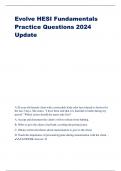Exam (elaborations)
Evolve HESI Fundamentals Practice Questions 2024 Update
- Course
- Institution
Evolve HESI Fundamentals Practice Questions 2024 Update A 20-year-old female client with a noticeable body odor has refused to shower for the last 3 days. She states, "I have been told that it is harmful to bathe during my period." Which action should the nurse take first? A. Accept and document ...
[Show more]



